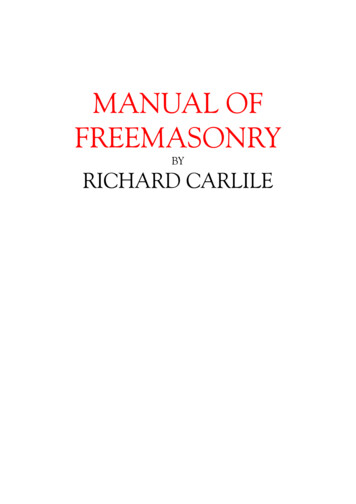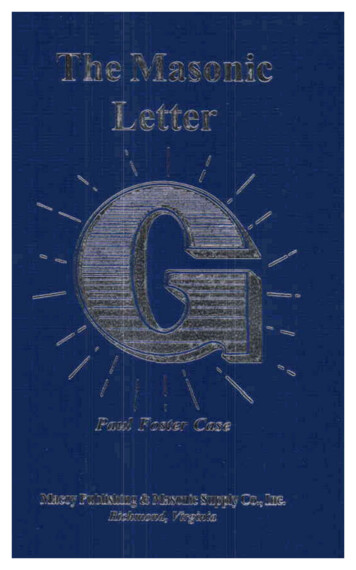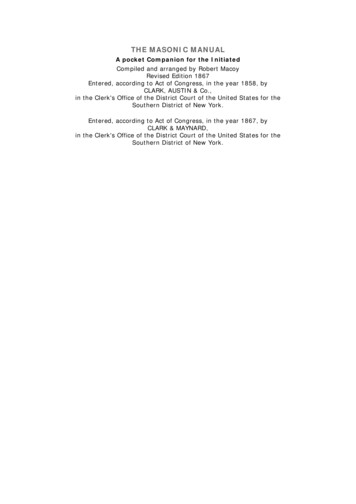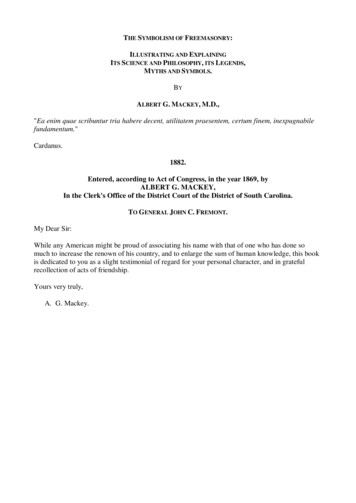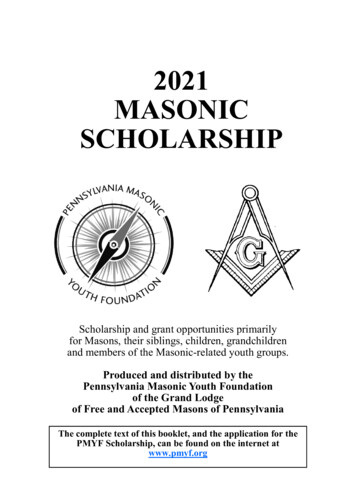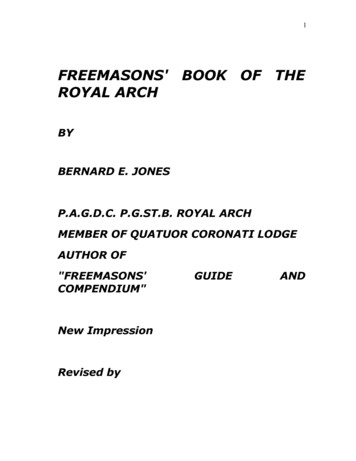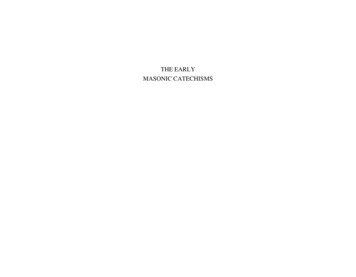
Transcription
THE EARLYMASONIC CATECHISMS
THE EARLYMASONIC CATECHISMS
THEEARLY MASONICCATECHISMSTRANSCRIBED AND EDITED BYDOUGLAS KNOOP, M.A., Hon. A.R.I.B.A.Professer of Economics in the University of SheffieldG. P. JONES, M.A., Litt.D.Lecturer in Economic History in the University of SheffieldANDDOUGLAS HAMER, M.C., M.A.Lecturer in English Literature in the University of SheffieldTHE SECOND EDITIONEDITED for QUATUOR CORONATI LODGEbyHARRY CARR, P.A.G.D.C., P.M.Published byQUATUOR CORONATI LODGE, NO. 2076, LONDON
1975
PRÉFACETO THE SECOND EDITIONThe first edition of this work appeared in 1943 and it was instantly recognized by historians as an indispensable tool for thestudy of the evolution of early masonic ritual. The book was very soon out of print, and for many years it has been virtually unobtainable. That a major work of this calibre should have had to wait twenty years for its second edition is perhaps a sad reflection on the limited field that exists for the more substantial works of masonic scholarship. Yet the workis not a whit less valuable to-day than when it was first published. Nothing has appeared to replace or supersede it,and its splendid thirty-page Introduction is as important to-day as it was in 1943.The present-day economics of printing tend to make any venture in the field of masonic publishing a matter of hazardousspeculation, but the Standing Committee of the Quatuor Coronati Lodge, No. 2076, agreed unanimously that the re-issue of thiswork should be the first undertaking in their newly enlarged publishing programme.Two important texts have been discovered since the first edition was published :1963 QUATUOR CORONATI LODGENo. 2076, LONDONFirst published 1943Second enlarged and revised edition 19631 The Wilkinson MS., c. 1727, which was the subject of a separate study by the same authors, in 1946.2 The Kevan MS., belonging to the period c. 1720, which was discovered in 1955.Second edition reprinted 19751It is noteworthy that the appearance of these widely different texts has served only to confirm the findings of thethree distinguished scholars who collaborated in the original work. In pursuit of their expressed . . endeavour to supply reliable texts of all theearly masonic catechisms . . we have included the Wilkinson and Kevan MSS. in this publication ;the former, complete with Introduction, photographs and Notes, as in the 1946 production ; the latter with a brief introduction and commentary by the present writer.The addition of these two texts is the only major différence betweenPrinted in Great Britain by Butler & Tanner Ltd, Frome and London
Prefacevithe first and second editions. It has necessitated changes in thepaging of the new book, with some additions to the Index, but the original transcripts have been preserved intact, and in this new form the second edition is really up to date, presenting in one slim volume reliabletranscripts of all the early English masonic catechisms that are known atpresent.Out of respect to the learned editors of the first edition, no changeshave been made to the Introduction. From the student's point ofview, no changes are necessary, except at those points where the textrefers to the actual number of documents reproduced., etc. (as on page3), and in similar items of a minor character which do not affect thescholarly quality of the Introduction.The location of several texts has changed in the twenty years that haveelapsed since the first edition was published. Three of the documentsreproduced here have changed ownership, and for the benefit of futurestudents we note the followingThe Gra ham M S., 1726, is now in the Library of the United GrandLodge of England.The D ialogue be tween Si mon and P hilip, c . 1740, is in the samePrefaceviitypescripts, two or more Brethren sharing Question and Answer.Even a longish text, like Prichard's Masonry Dissected, would require onlya moderate amount of preparation, and in this form it is possible to give.agreat deal of entertaining and simple instruction in the early developmentof the ritual.The Early Masonic Catechisms is by far the mort important work that wasever compiled in this particular field of masonic study. Primarily, itwas designed for students, but not for them alone. There is a greatdeal of profit and pleasure to be derived from it for the rank and file ofthe Craft, if its contents are studied as they deserve.Finally, and on behalf of the Quatuor Coronati Lodge, No. 2076, London, I take this opportunity of expressing our thanks to Professor G. P.Jones and to the authorities of the University of Sheffield for theirvalued help in permitting this publication; also to the Grand Lodgeof Scotland and to the various Libraries and individuals (all listed inthe Preface to the first edition, below), who granted permission to reprintthe rare and valuable documents which are reproduced here.H. C.1963Library.The Wilkinson MS., c. 1727, belongs to the Pomfrct Lodge, No. 360(Northants.), and is on loan to the same Grand Lodge Library.Writing as one who has devoted much time to the study and teaching ofmasonic ritual, I offer the following hints—with some diffidencein thehope that they will enable less-experienced students to enjoy the workmore fully. For the untrained reader the old English and Scottish spellingand a few unusual words may present some difficulties, but they willdisappear very quickly, and he will soon find that it is much more interesting to read the texts in their original form than in modem spellings which seem somehow unsuited to the words themselves.At first the reader will automatically find himself comparing these oldcatechisms with the present-day ritual. Later, there is much pleasureand instruction to be gained by comparing the earlier texts, c. 1700, withthe more highly developed versions of the 1730s.For study purposes, especially in Lodges and Lodges of Instruction, it isextremely useful to read the texts aloud, from the book or fromPREFACETO THE FIRST EDITIONThe early masonic catechisms have been examined, analytically andcomparatively, in some detail by Bro. H. Poole in " Masonic Ritual andSecrets before 1717 " [A.Q.C., xxxvii (1924)]. His paper, however,was written before the discovery of the Chesham, E dinburgh RegisterHouse and Graham M SS. Further, although he actually took 173o, inpreference to 1717, as his boundary date, notwithstanding his title, heexcluded Prichard's Masonry Dissected, published in October, 173o, on theground that it raised the large question of the number of degrees ' givenduring the period 1717-1730, which he felt unable adequately to discuss inthe space at his disposal. Much of his paper is as valuable to-day as whenit was first written, some twenty years ago, though failure to distinguishbetween an apprentice and an
viiiPrefaceentered apprentice and to realize that the catechisms apply to the admissionof the latter (ex-apprentices or improvers aged 21 or so) and not to thatof the former (boys aged 14 or so) did lead him to some extent astray,and some of the commentators on his paper more so. Unfortunately, Bro.Poole's paper has no appendix of illustrative documents ; owing to lack ofspace, he had to content himself with indicating the more accessiblereproductions. Thus, though it stimulated interest in the catechisms, hispaper whetted the appetite without supplying any ready means of satisfying it, because some of the publications in which catechisms have beenreproduced are not likely to be found in an ordinary masonic library.In this volume, which may be described as a utility ' edition, we endeavour to supply reliable texts of all the early masonic catechisms, and ofthe contemporary rejoinders, with the exception of the Chesham MS.and the first part of the Essex MS., which are practically identical withother early catechisms which we print in full. As space is limited, wehave curtailed our general introduction and the introductory and explanatory notes to particular documents, and have omitted reproductions of titlepages of pamphlets and specimen pages of MSS. Further, we have beenunable to follow the exact lay-out of certain catechisms, in so far as theydevote separate limes to each question and each answer, however short. Inthese days of paper economy such spacious setting is precluded. Ouraim is to give complete and accurate texts of the documents, with sufficient introductory and explanatory matter to help those masons who wichto study for themselves the origins of masonic ritual and ceremonies. Theprevailing conditions prevent us from catering for the masonic bibliophile.For the facilities afforded to us in the obtaining of photostats and photographs, and for permission to print or reprint documents, we have tothank the authorities of the British Museum, the Bodleian Library, theTrinity College, Dublin, Library, the Edinburgh Register House, theUnited Grand Lodge of England, the Grand Lodge of Ireland andLodge Dumfries Kilwinning, No. 53 ; also the Editors of A.Q.C. and ofthe Leicester Masonic Reprints, and Bro. Rev. H. I. Robinson, Bro. Rev. H.Poole, Bro. J. Heron Lepper and Bro. Philip Crossle. We have also tothank Bro. Rabbi Barnet I. Cohen for assistance with certain Hebrew words ; Bro. Philip Crossle for information about the ChetwodeCrawley MS. ; Dr. B. Schofield and Mr. A. J. Collins of the MSS. Department of the British Museum forPrefacehelp in dating certain manuscripts ; and our colleagues, J. M.Jenkinson and J. H. Read, for making the tracings requiredthe preparation of blocks. Lastly, we have to thank Mr. H.McKechnie, Secretary of the Manchester University Press, forunfailing help and co-operation.D. K.G. P. J.D. H.ixM.forM.hisTHE UNIVERSITY,SHEFFIELD,February, 1943.Postscript. We are greatly indebted to Bro. Fred. T. Cramphornfor placing at our disposai his typescript copies of the two catechismsreferred to in the Note on p. xi.April, 1943.
CONTENTSLIST OF ABBREVIATED REFERENCESA.Q.C.INTRODUCTION :COMPARISON WITH THE OLD CHARGES .EARLY OPERATIVE WORKINGAUTHENTICITY OF THE PRINTED CATECHISMS :149Relation of Printed to MS. Catechisms .Reaction of the Craft to the Publication of the CatechismsCLASSIFICATION OF THE EARLY CATECHISMS .EVOLUTION OF THE EARLY CATECHISMSACCEPTED OR EARLY SPECULATIVE CEREMONIESTREATMENT OF THE TEXTS .101318Misc. Lat. .192230CATECHISMS :THE EDINBURGH REGISTER HOUSE MS., 169631THE CHETWODE CRAWLEY MS., C. 170035ThorpTHE KEVAN MS., C. 1 7 1 4 - 2 039THE SLOAN E MS., 3329, C. 1700.45THE DUMFRIES No. 4 MS., C. 1710 .50THE TRINITY COLLEGE, DUBLIN, MS., 171169A MASON'S EXAMINATION, 1723 .71THE GRAND MYSTERY OF FREE-MASONS DISCOVER'D, 1724 76THE WHOLE INSTITUTION OF MASONRY, 172481INSTITUTION OP FREE MASONS, C. 1725 .83THE WHOLE INSTITUTIONS OF FREE-MASONS OPENED, 1725 87THE GR AHAM MS., 1726 .89THE GRAND MYSTERY LAID OPEN, 172697A MASON'S CONFESSION, ? 172799THE WILKINSON M S . , C. 1727108THE MYSTERY OF FREE-MASONRY, 1730152PRICHARD'S MASONRY DISSECTED, 1730157THE CHESHAM MS., C. 1740174DIALOGUE BETWEEN SIMON AND PHILIP, C. 1740175THE ESSEX MS., C. 1750 .182REJOINDERSTHE FREE-MASONS VINDICATION, 1725 .THE PERJUR 'D FREE MASON DETECTED, 1730A DEFENCE OF MASONRY, 1730-I184187210POSSIBLE REJOINDERS :THE SISTERHOOD OF FREE SEMPSTRESSES, 1724A LETTER FROM THE GRAND MISTRESS, 1724NOTES AND GLOSSARY226229240INDEX243.GouldLeics. ReprintsLepper and CrossleManc. Trans.Misc. LatQ.C.A.ThorpArs Quatuor Coronatorum [Transactions of the QuatuorCoronati Lodge, No. 2076, London].R. F. Gould, History of Freemasonry, 1882-7.Masonic Reprints [of the Lodge of Research, No. 2429,Leicester].J. H. Lepper and. Philip Crossle, History of the Grand Lodge of Ireland, 1925.Transactions of the Manchester Association for MasonicResearch.Miscellanea Latomorum.Quatuor Coronatorum Antigrapha [Masonic Reprints ofthe Quatuor Coronati Lodge, No. 2076, London].J T Thorp, Bibliography of Masonic Catechisms and Exposures, 1929.NOTE TO TTHE FIRST EDITIONAfter this book had gone to press, the existence of two other early catechismswas brought to our notice by Bro. Fred. T. Cramphorn of Upper Moulsham,Chelmsford. In a MS., stated to bear an almost illegible name and address, "M r John Page . N o 5 . . . Bristol ", and recently in the possession of the lateBro. Lister Salisbury, who lent the document to Bro. Cramphorn to copy, thereare three catechisms : (i) The Whole Institution of Masonry, 1724 ; (ii) an entryheaded " The following is part of Free Masonry as Printed in London 1725 " ; ADialogue between Simon, a Town Mason, and Philip, a Traveling Mason. Thefirst is an early and shorter version of The W hole I nstitutions o f F ree-MasonsOpened, 1725 (see p. 87 below) ; the second is a copy of the examination in TheGrand Mystery of the Free Masons Disco ver'd , 1 72 5 ( see p . 7 6 b elo w) ;the thir d p o ssesses co ns id er ab le affini ties with other early masonic catechisms, but resembles no particular one very closely. We print the first and third,with introductory notes, on pp. 81 and 175 below ; it has not been possible,however, to refer to them in the Introduction, which was already paged.xxi
INTRODUCTIONCOMPARISON WITH THE OLD CHARGESFor many years the study of masonic manuscripts has been largely directed to the documents known as the MS. Constitutions of Masonry, or, more familiarly, as theOld Charges. These usually begin with an invocation or opening prayer, followed by a legendary history of the building industry and a body of regulations governingthe masons' trade. This study has been distinctly fruitful, and has led to the discovery of numerous new versions of the Old Charges, so that there is a fairly substantial body of material available for classification and analysis. The genuineness of the documents as a whole has never been seriously questioned, thoughGould devoted considerable space in his History of Freemasonry to considering how far any particular version could be regarded as an accredited or authoritative writing, and the authenticity of one or two versions has provided matter for discussion. The legendary history and the masons' regulations of the MS. Constitutions fromtime to time underwent considerable changes, which we have briefly discussed in our Short History of Freemasonry 1730, but no revision appears to have been madeafter about 1725. Although a particular version may not have been copied or printed until the late eighteenth or early nineteenth century, nevertheless it will generallyprove to be a more or less exact copy of a pre-1730 manuscript. Consequently, there is no need to impose a date-limit when discussing the Old Charges, or to differentiate between the versions which have survived in manuscript and those which have survived only in print.In this volume we deal with a different class of masonic document, much smaller in number and considerably more suspect in character, namely, the manuscriptand printed masonic catechisms, which originally were mainly concerned with the form of giving the Mason Word, and the questions and answers used to testpersans claiming to have the Mason Word. These catechisms underwent considerable changes during the eighteenth century, gradually becoming much more elaboratein character. Lionel Vibert devoted some attention to this development in his Prestonian Lecture for 1925 on the Trigradal System, and subsequently discussed it morefully in a paper on " Eighteenth
2IntroductionCentury Catechisms " (Misc. L at., xiv). As we are concerned onlywith early masonic catechisms, we have taken as the end of ourperiod the year 1730, which for three reasons forms a good boundary date.(i) For several years after 1730, Prichard's Masonry D issected, firstpublished in October 1730, had no rival as a masonic catechism in thiscountry. (ii) For a time after 1730, commencing in 1734-5, masonicpublications in England mainly took the form of Pocket C ompanions,popular masonic handbooks, which temporarily displaced i nte r e st i ncate c hi s ms o r r it u al s. C o mme n ci n g i n 1 7 3 7 -8 , translations ofFrench exposures ' began to appear, and French influence on the development of masonic ceremonies, began to make itself felt. Although wetake 173o as the end of our period, we do, however, bring under reviewfour later documents, the Institution of Free M asons, of uncertaindate, but assigned to the first half of the eighteenth century, theChesham MS. of c. 1 740, the Essex MS of c. 175o, and A Mason's Confession of 1755. All of these appear to relate to conditions prevailing inthe third decade of the eighteenth century, rather than to the period atwhich they were written or printed.Our sixteen documents cover the period 1696 to 1730, twentyoneyears before the formation of Grand Lodge in 1717, and thirteen after itsestablishment. Nevertheless, these thirty-four years can be regarded asconstituting a unity, for freemasonry in the third decade of the eighteenth century appears to have been substantially the same as in the immediate pre-Grand Lodge period. Thus we are primarily concerned withthe first thirty years of the eighteenth century, a period when accepted or speculative rites were being evolved out of the older operativepractices and customs ; this very possibly accounts for the somewhat diverse conditions pictured in the different documents. On the other hand,the third decade of the eighteenth century was a period in which publiccuriosity about freemasonry was widespread, and this makes it very necessary to be on guard against possible hoaxes or forgeries, more especially inthe case of the printed versions, or so-called exposures which usuallydaim to be either confessions of disgruntled masons, or compilationsfrom the papers of deceased brethren. As no authoritative ritual forthis period has survived (assuming that one ever existed), we can neverfeel sure how far any particular document reflects what happened in anyparticular lodge, or, assuming that the document was genuine, and not amere skit or hoax on current practice, how widespread-its use was. Thus aconComparison with the Old Charges3siderable element of uncertainty must always remain in interpretingthese documents, even after their authenticity has been established, so far asthat can be done.In this volume we are concerned primarily with sixteen documents, nineof which are in manuscript [but see also Preface, p. v.]:Edinburgh Register House MS., 1696,Chetwode Crawley MS., c. 1700,Sloane MS. 3329, c. 1700,Dumfries No. 4 MS., c. 1710, TrinityCollege, Dublin, MS., 1711, Institution ofFree Masons, c. 1725, Graham MS., 1726,Chesham MS., c. 1740,Essex MS., c. 1750,and seven in print :A Mason's Examination, 1723,The Grand Mystery of Free-Masons Discover'd, 1724,The Whole Institutions of Free-Masons Opened, 1725,The Grand Mystery Laid Open, 1726,A Mason's Confession, ? 1 72 7 [printed 1755],The Mystery of Free-Masonry, 1730,Prichard's Masonry Dissected, 1730.Both Thorp (p. 11) and Bro. Baxter (Manc. T rans., xxx, 78) includetwo other publications among the early catechisms and exposures, viz.,the Briscoe pamphlet and The Perjur'd Free Masan Detected. We deliberately exclude the former, The Secret H istory o f t he Free-Masons(1724), because it is principally a version of the Old Charges, with observations on Anderson's Constitutions, and in no sense a catechism. The latterpamphlet, a reply to Prichard's Masonry D issected, does include agood deal of dialogue, and may perhaps be regarded as a catechism,though of an unusal type. We prefer to treat it as a reply to a catechism,and accordingly print it with the other Rejoinders.The fact that we have been able to trace only nine versions of the MS.catechisms written, or relating to the period, before 1731, whercas someseventy versions of the MS. C onstitutions copied before that date havebeen discovered, may perhaps be accounted for in three ways. (i) TheMS. catechisms, usually written on one or two sheets of paper, are morelikely to have been mislaid or destroyed than versions of the
4IntroductionOld Charges, which are frequently in the form of books or rolls. (ii)As the subject matter of the catechisms was partly esoteric in character, it would presumably be imparted orally, and the possessors of the necessary knowledge would be chary about committing it to writing, thoughdoubtless that might be done occasionally as an aid to memory. Even thewriting of such a guide, however, is prohibited by Dumfries N o. 3 MS.(iii) When catechisms had been committed to writing, the documentsmay have been deliberately destroyed after they had served their immediate purpose. Thus, according to Anderson (Constitutions of 1738, p.in), several valuable manuscripts concerning the Fraternity, their lodges,regulations, charges, secrets and usages, were burnt by some scrupulousbrothers in 1720, so that these papers might not fall into strange hands. Nevertheless, we are disposed to think that when the importance of this class ofdocument is more fully appreciated, and when the quest for such documents has received the same attention as the quest for new versions of theOld Charges, more versions of the MS. catechisms may be discovered. Of theexisting nine versions, Sloane MS. 3329 was known to masonic students inthe 1860's ; Dumfries N o. 4 M S. was discovered in 1891 ; the TrinityCollege, Dublin, MS. had been traced in or before 1898 ; the ChetwodeCrawley M S. was discovered in 5904, and the Institution of F ree M asons about 590 5 ; the Essex M S. was known in 1955 and probably earlier ; the Chesham M S. was found in 5929, the Edinburgh Register H ouseMS. in 1930, while the existence of the Graham M S. was only madeknown as recently as 19 36. Of the printed versions, two broadsheets,The Whole Institutions of Free-Masons Opened and The Grand Mystery Laid O pen, were mere turnes to most masonic students untilBro. Poole reprinted them in A.Q.C., 1., in 5937. Actually, the discoveries of the last ten or fifteen years have added not only to the number ofversions of the catechisms known, but also quite materially to the body ofknowledge concerning early eighteenthcentury masonic working. By wayof contrast, it may be noted that recent discoveries of versions of the OldCharges have merely confirmed legends and regulations, the existence ofwhich was already well established.EARLY OPERATIVE WORKINGBefore we can discuss the authenticity of the catechisms in general, or ofany one catechism in particular, we must first briefly examine6Introductionremoved, after taking an oath of secrecy, out of the company with theEarly O perativeWorking5 what isknown from independent sources about early operative working, so that wemay be in a position to judge how far the catechisms confirm or contradictsuch independent information as is available on the subject. The information may be briefly stated as followsi. The Schaw Statutes of 1,598 required the selection of intenders orinstructors by each new fellow craft on his admission.ii.The minutes of the Lodge of Edinburgh for the first decade of theseventeenth century show that this provision of the Schaw Statutes was effective.iii.The m inutes of t he L odge of A itchison's H aven, f rom t heircommencement in 1598, show not only that a new fellow craft, whenadmitted, c hose two fe llow c rafts a s h is in tenders a nd in structors,but al so t hat a ne w e ntered apprentice on his adm ission, similarly selected two entered apprentices as his intenders and instructors.To judge from the Edinburgh and Aitchison's Haven minutes, in most cases,if not all, the intenders and instructors were the most recently admittedfellow crafts and entered apprentices respectively. As candidates had togive satisfactory proofs of their technical qualifications before admission, itis difficult to understand what functions these intenders discharged, unlessit were to instruct the candidates in the esoteric knowledge associated withthe grade to which they had just been admitted. That this was the caseseems to be borne out by the following passage at the end of Dumfries No.3 MS.1, a late seventeenth-century version of the Old Charges whichbelonged to the Old Lodge of Dumfries, now Dumfries Kilwinning, No. 53 :Then let ye person yt is then made a mason chuse out of ye lodge a masonwho is to instruct him in those secrets which must never be written,& he is to call him tuter. then his tuter will take him acide & showhim ail ye whole mistery, yt at his return he may exercise with ye rest ofhis fellow masons.A similar passage occurs at the end of Harris No. 1 MS., of approximatelythe same date, and also near the end of the Thos. Carmick MS. of 1727.Nothing, however, is known about the early history of either of these versionsof the Old Charges.We learn from the Edinburgh Register House and Chetwode CrawleyMSS. that the person to be admitted as an entered apprentice was 1Printed in Smith, History of the Old Lodge of Dumfries, 103.youngest mason to learn from him the signs, postures and words of hisentry, and similarly that the person to be admitted as a fellow craft
or master mason, after taking an oath of secrecy, was sent out of thecompany with the youngest master to learn the postures, words and signs offellowship. Further, the appointment of ' attenders ' is indicated in SloaneMS. 3329 ; the candidate had to swear to keep secret all that his attenders bid him keep secret. According to A Mason's Confession, oneperson in the lodge instructed the candidate a little about the secrets thesame day that he entered, and was called his author Another personin the lodge, whom the candidate selected to be his instructor for theensuing twelve months, was called his intenderiv. From the Mark Book of the Lodge of Aberdeen, the first recordsin which were written in 1670, we learn that it was ordained by themembers in that year that the so-called Measson Charter', i.e., theversion o f t he MS. Constitutions now k nown a s t he Aberdeen MS.,was to be read before a m eeting of masons, and presumably, t herefore, at the admission of every entered apprentice.That the regulations or charges, if not the history or legend, were readto the candidates is stated in the Aberdeen MS. itself, as also in the Aitchison's H aven M S., which was engrossed in the Minute Book of theAitchison's Haven Lodge in 1666. The same is truc of versions of theOld Charges which belonged in the second half of the seventeenth century to the old Scottish lodges at Kilwinning, Stirling, Melrose, andDumfries.According to the oath in the catechism Sloane MS. 3329, the candidatewas to swear to keep secret " the mason word and everything thereincontained " and " truly observe the charges in ye constitution ", whichimplies that at least the charges or regulations of the MS. Constitutionshad been read to the candidate before the oath was taken. From the printedcatechism, A Mason's Examination, we learn that " when a Free-Mason isenter'd . . . he is to hear the * * * * * belonging to the Society read to himby the Master of the Lodge ". The asterisks, resulting possibly from ignorance of masonic terms, or from difficulty in deciphering the manuscript onwhich the printed version was in all probability based, are tantalizing, but itseems not unreasonable to fill the gap with the word constitutions ' or charges'. In making this suggestion, we merely follow the instructions con-Early Operative Working7tained in Anderson's Constitutions of 1723 (published a few weeksbefore A Mason's Examination) that the history and charges (as printed inAnderson) should be read at the admission of a new brother. If thefive asterisks are intended to represent five letters, we suggest rules' asa possible solution.v. A ccording to t he first statute in t he Laws and St atutes o f theLodge of Aberdeen, adopted or confirmed 27 December 1670, the master masons and entered apprentices received the benefit of the Mason Wordat their entry.Although all the catechisms do not distinguish very clearly between (a)entered apprentices and (b) fellow crafts or master masons, several ofthem do so, and make it quite clear that the entered apprentices received the benefit of the Mason Word at their entry, as stated in theAberdeen Statutes. Further, some catechisms show that additional esotericknowledge was imparted to candidates when they were admittedfellow crafts or master masons, though whether that was the case atAberdeen is not clear from the Statutes of the Lodge.vi.The surviving fragment of a minute of the Lodge of Haughfoot,dated 22 December 1702, c ontains w hat app ears t o be t he closingportion of the description of the admission of a fellow craft or master mason. To show the significance of this fragment, we set it out side by side withan extract from the Edinburgh Register House MS. :Haughfoot fragment 1of entrieas thc apprentice did Leaving out( Th e C o m m o n J u d g e ) Th e nthey whisper the word as before —and the Master Mason grips hishand after the ordinary way.Edinburgh Register House MS. . . He makes the masters sign, and sayesthe same words of entrie as the apprenticedid only leaving out the common judge thenthe masons whisper the word among themselves begginning at the youngest as formerly. . . Then the master gives himthe word and gripes his hand after the masonsway.vii. Certain seventeenth-century versions of the Old Charges contain an oath of s ecrecy w hich pr esumably f ormed par t of the c eremony ofadmission.To facilitate comparison between these oaths and those embodied incertain MS. catechisms, we print three from the Old Charges and twofrom the Catechisms side by side :1Vernon, History of Freemasonry in Roxburghshire, 282.
8Authenticity of the Printed CatechismsIntroductionOLD CHARGESBuchanan MS.1, C. 1670These Charges that you haue Received you shall well and trulykeepe not discloseing the secresy ofour Lodge to man woman norChild : sticke nor Stone : thingmoueable nor vnmoveable soe godyou helpe and bis holy DoomeAmenDrinkwater N o. i M S., c . 2700CA
the grand mystery of freemasons discover'd, 1724- 76 . the whole institution of masonry, 1724 81 . institution op free masons, c. 1725 . 83 . the whole institutions of freemasons opened, 1725 - 87 . the graham ms., 1726 . 89 . the grand mystery laid open, 1726 97 . a mason
